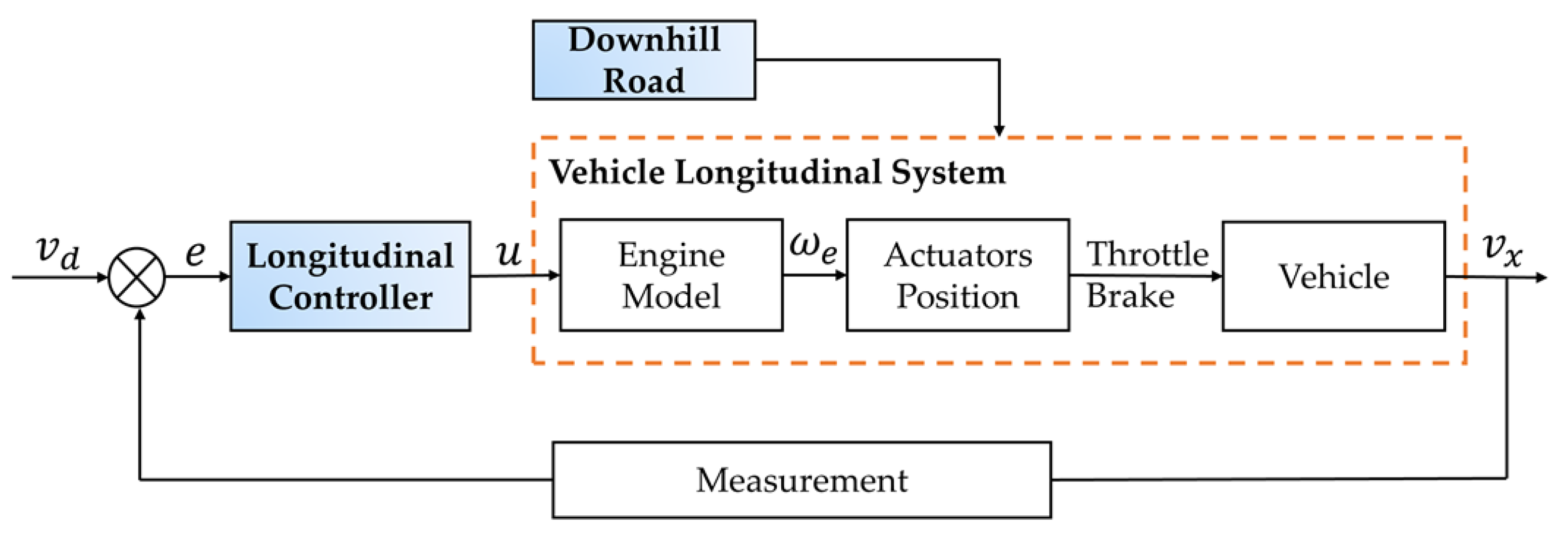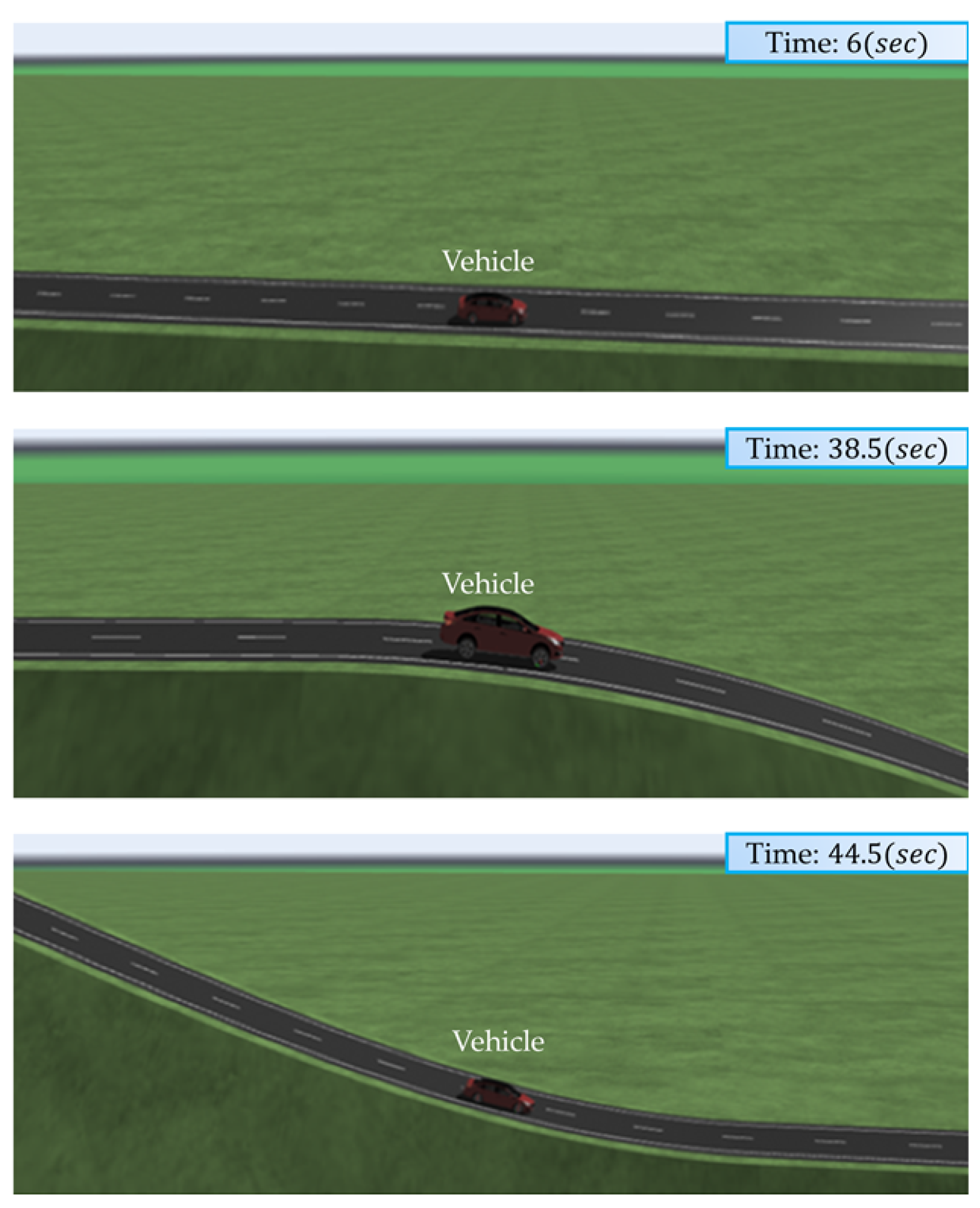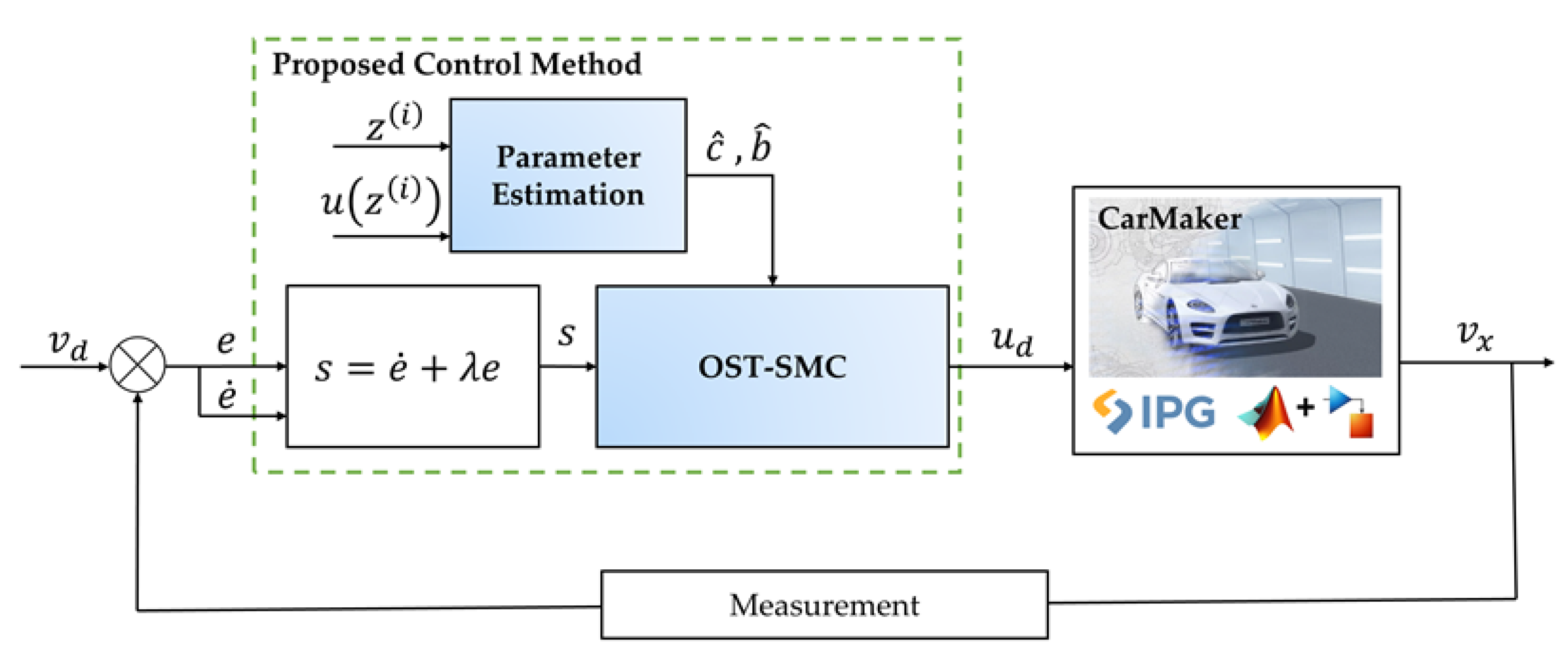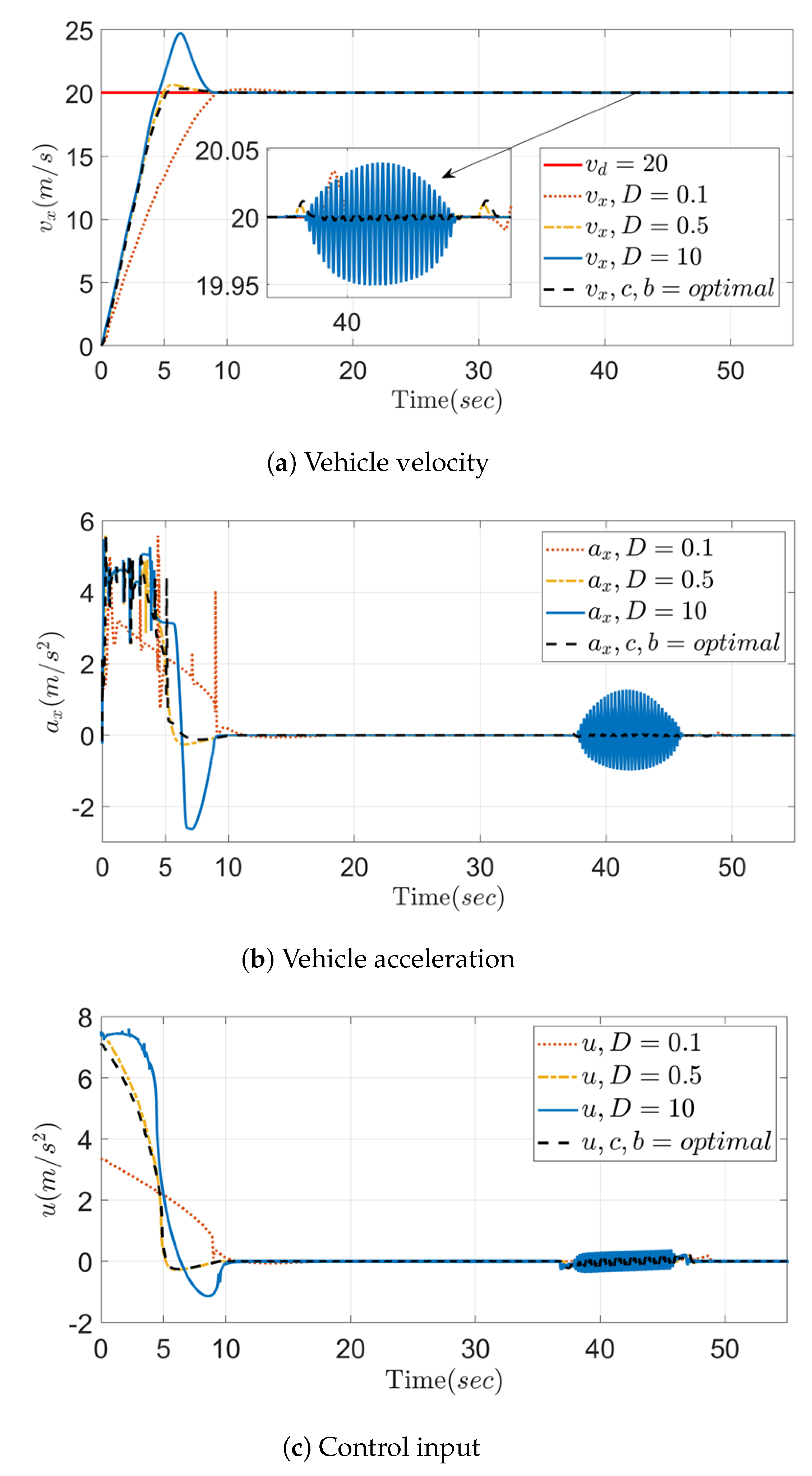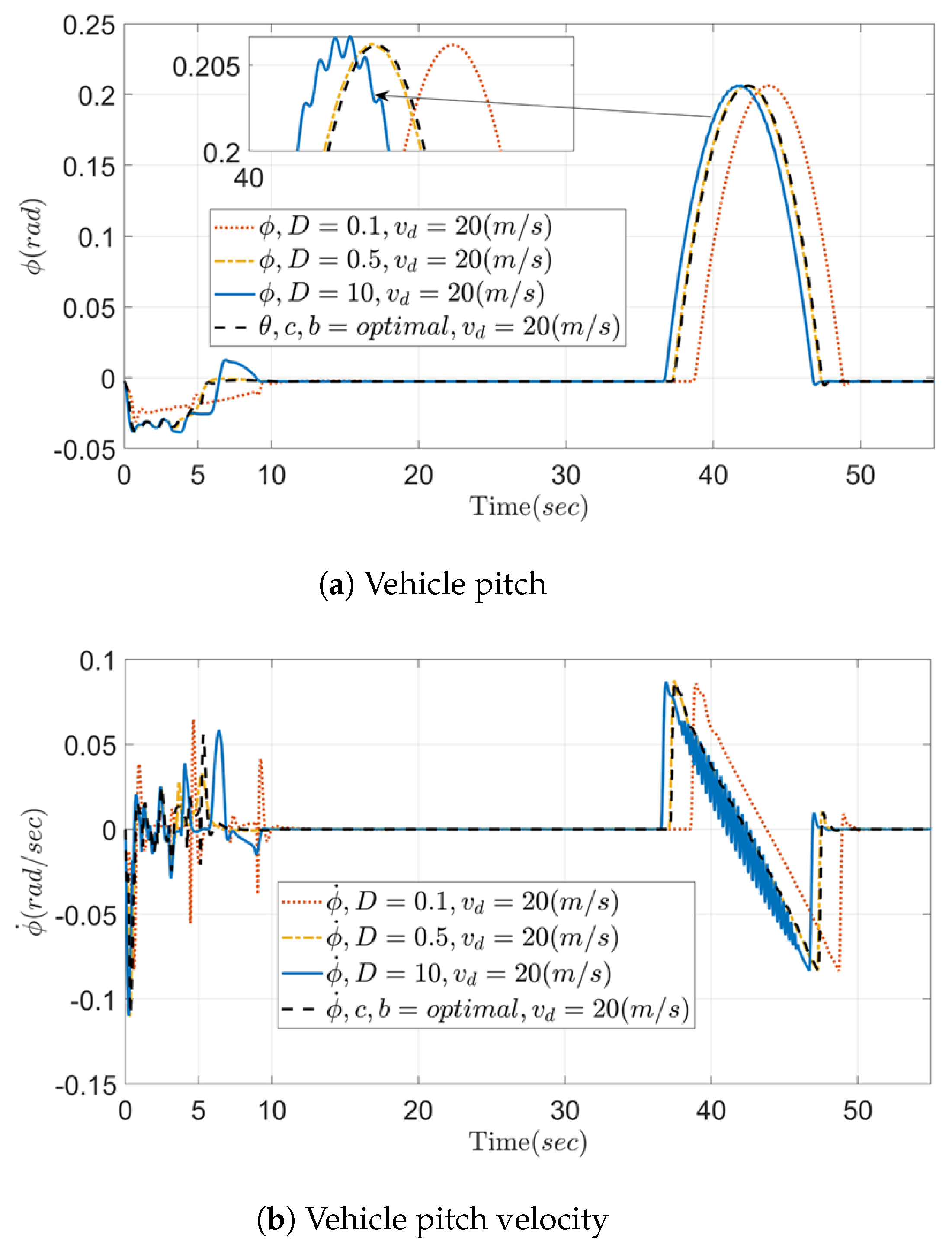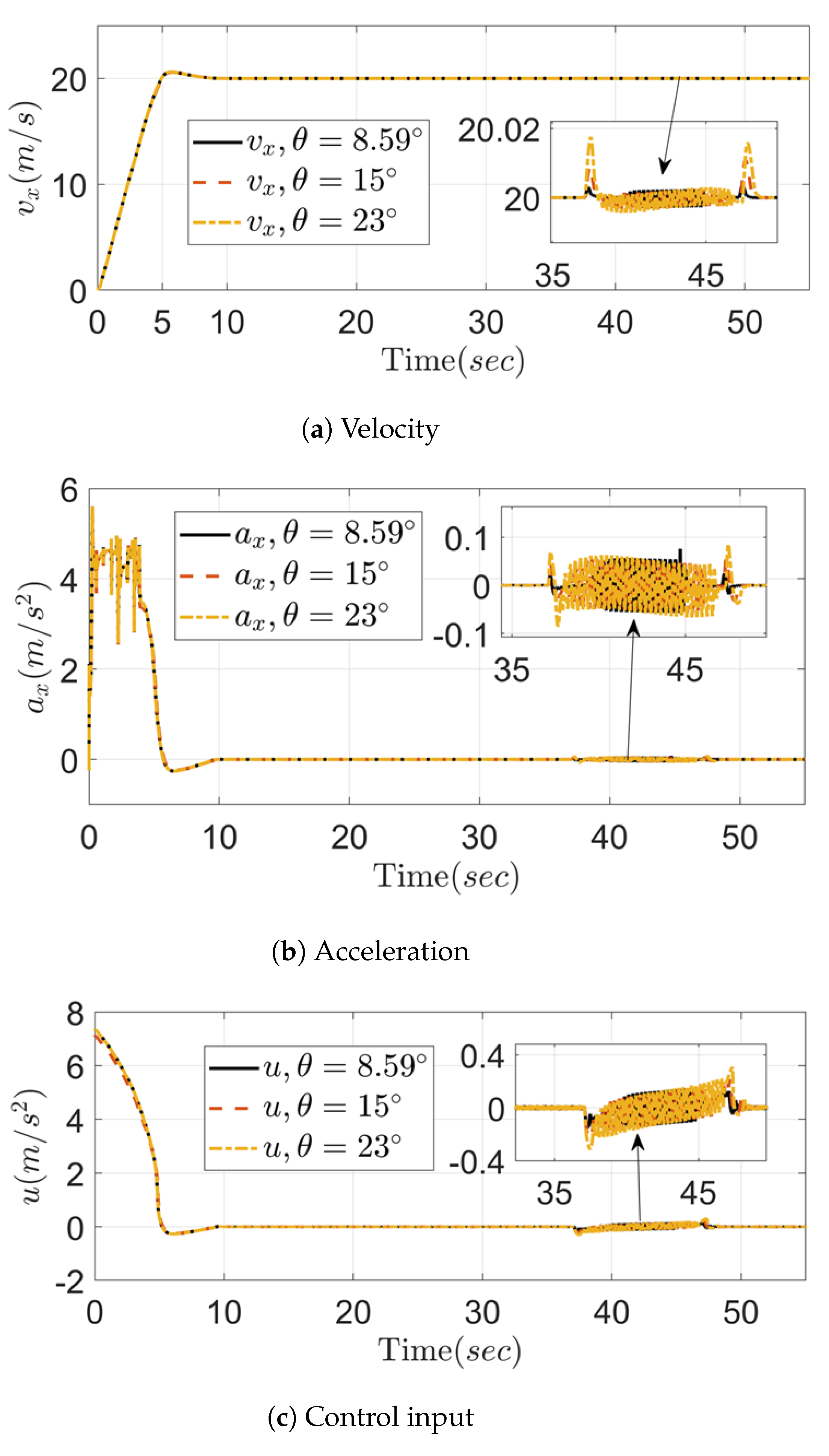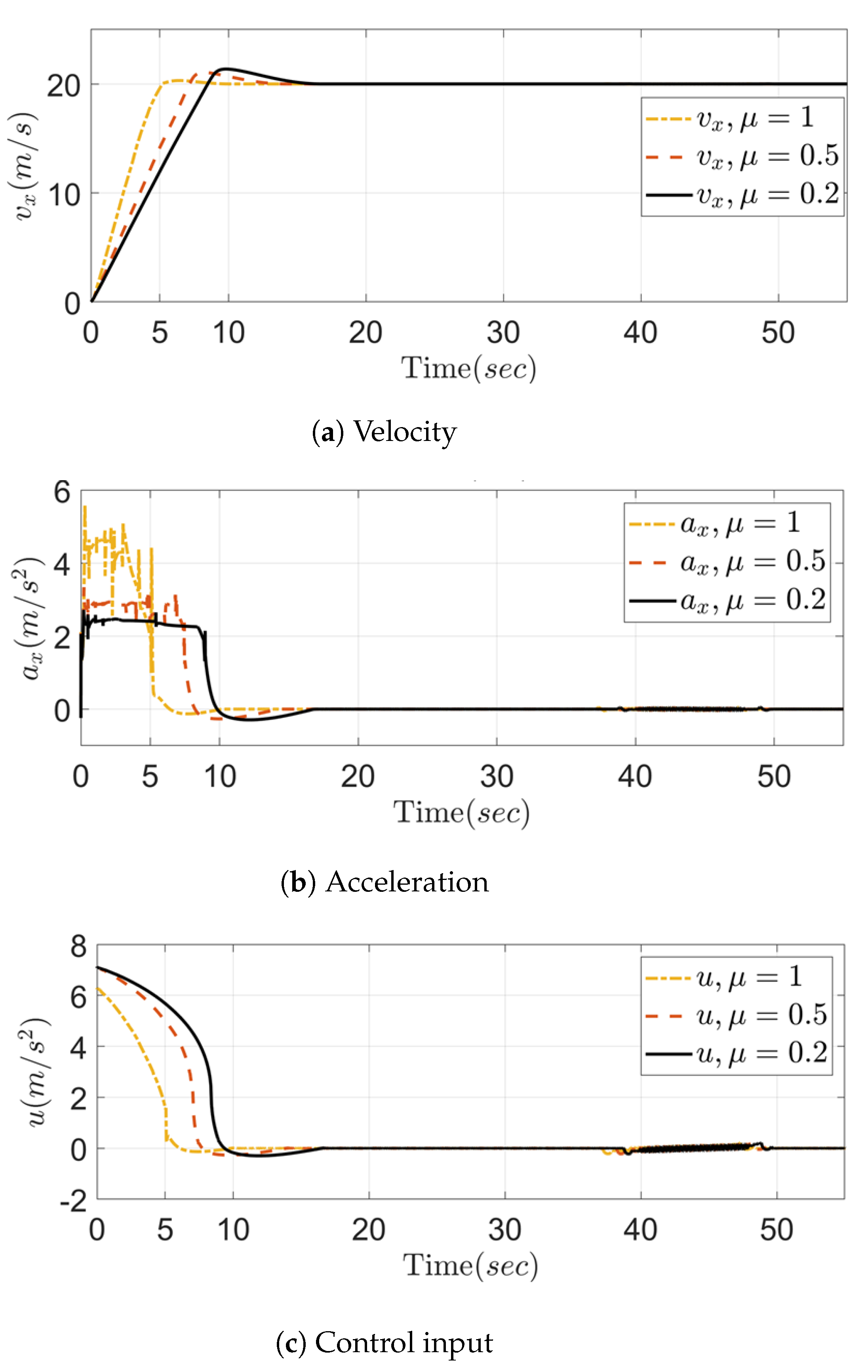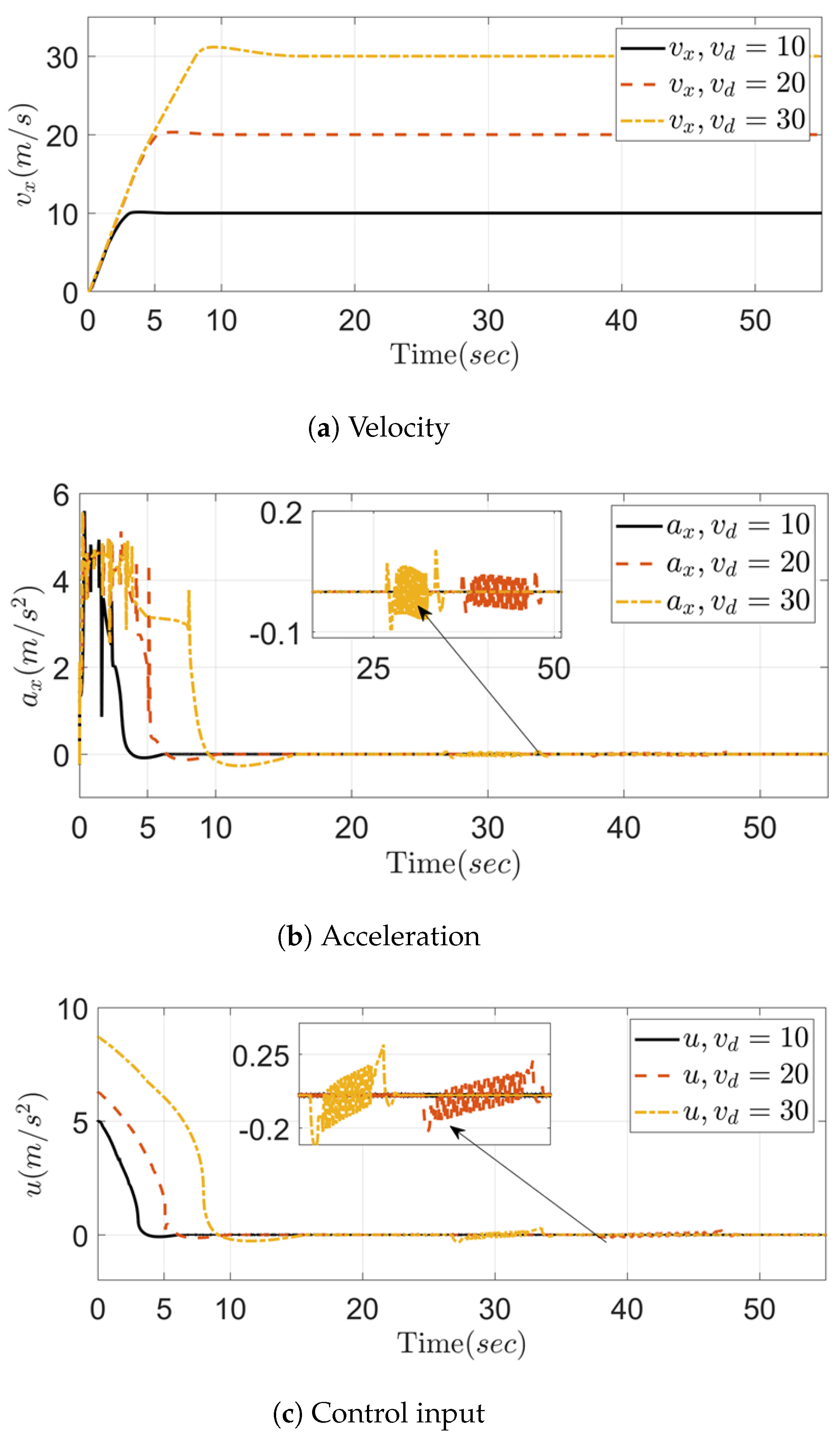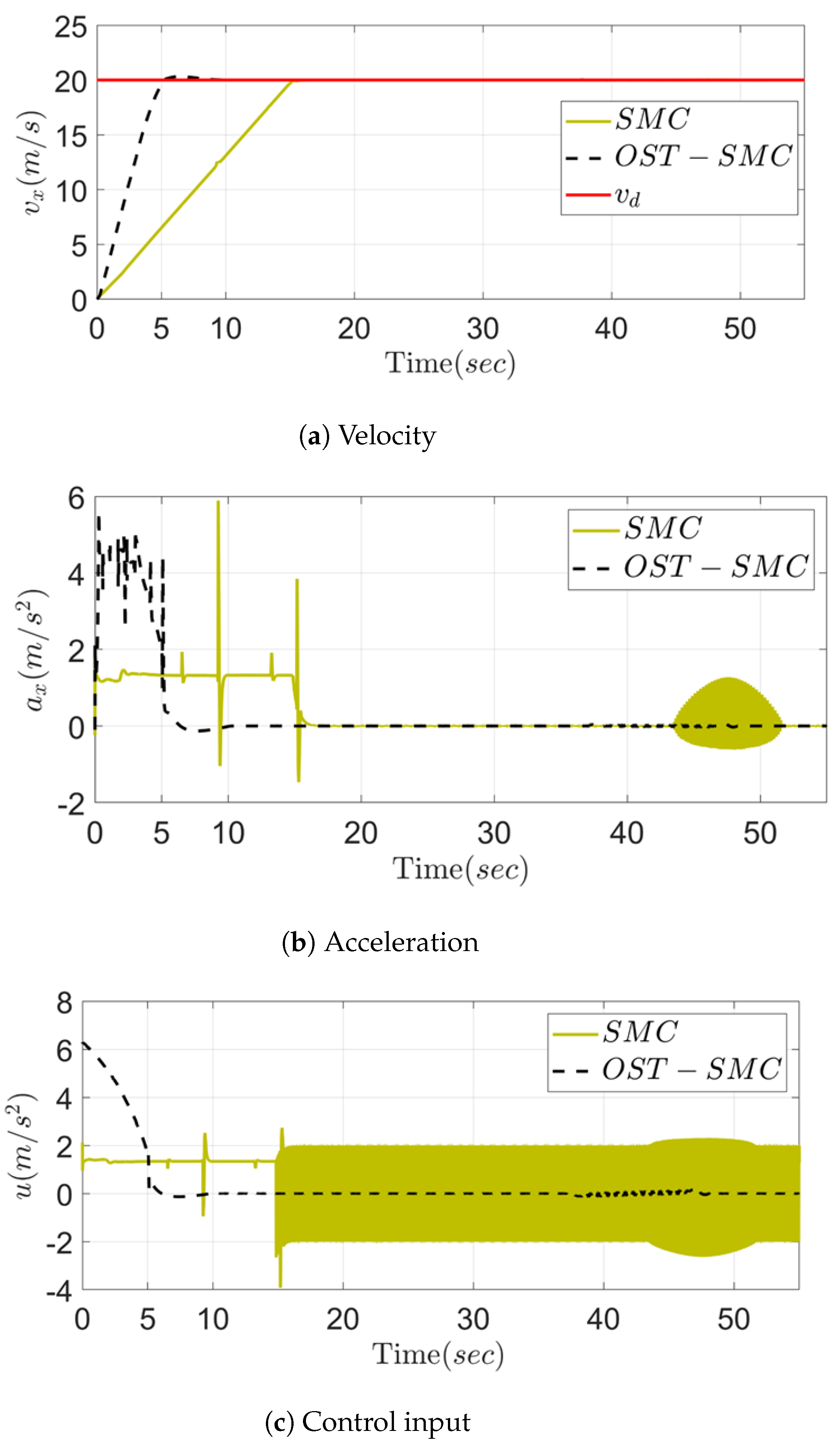1. Introduction
Recent advancements in autonomous driving systems have significantly contributed to the extensive research and development of longitudinal vehicle motion control at various levels. Commonly implemented longitudinal control systems in modern passenger vehicles include cruise control, anti-lock braking systems (ABS), and traction control systems [
1,
2,
3]. Beyond these, more advanced longitudinal control technologies have been the subject of intensive research, such as radar-based collision avoidance systems, adaptive cruise control (ACC) systems, individual wheel torque control with active differentials, and longitudinal control systems designed for vehicle platooning in automated highway systems [
4,
5]. Longitudinal control primarily governs a vehicle’s throttle and braking mechanisms. For instance, traditional cruise control systems manage only the throttle, allowing a vehicle to maintain a relatively constant speed without the driver needing to press the accelerator. This feature has become a standard in modern vehicles, significantly enhancing driver comfort during long-distance travel. By relieving drivers from the physical effort of maintaining pedal pressure and the mental effort of monitoring speed to avoid speeding tickets, cruise control systems help reduce both physical and cognitive fatigue during highway driving. A basic cruise control system allows the driver to set a speed reference using a simple push-button interface [
6,
7].
The longitudinal control system, such as cruise control, is designed to maintain the vehicle’s speed set by the user and ensure that the system consistently achieves the desired output. This can be achieved by various methods of the controller such as using proportional-integral derivatives (PID) controller, fuzzy logic controller, and many more [
8]. SMC has been widely applied to nonlinear systems, multi-input multi-output (MIMO) systems, discrete-time models, large-scale and infinite-dimension systems, and stochastic systems. The most eminent feature of SMC and its type is that it is completely insensitive to parametric uncertainty and external disturbances during sliding mode but suffers from chattering phenomena on its control input [
9,
10,
11]. Many researchers have been working on longitudinal control systems, the following papers are some of them. In [
1], the authors have designed a conventional PI as upper controller for cruise controller system, a PID controller design for cruise control system using a genetic algorithm [
6], a cruise control system with feedforward controller for all-terrain vehicles [
12], a cruise control design using fuzzy logic controller [
13], an optimal PID controller for an automobile cruise control system [
14], an optimized robust cruise control system for an electric vehicle [
15], a cruise control for electric vehicle based on ADRC controller considering driver’s behavior [
16], a cruise control based on gain scheduling PI diesel engine speed controller [
17], a historical review on lateral and longitudinal control of autonomous vehicle motions [
18], sliding order and sliding accuracy in sliding mode control [
19], finite time stability and robust control synthesis of uncertain switched systems [
20], nonlinear distance and cruise control for passenger cars [
21], smooth second-order sliding modes: Missile guidance application [
22]. Autonomous vehicles (AVs) require accurate dynamic models to operate safely and efficiently under diverse conditions, especially at driving limits. Reference [
23] introduced a deep learning-based hybrid dynamic modeling approach that combines data-driven techniques with classical dynamic equations to enhance accuracy in modeling vehicle behavior under these conditions. Their study demonstrates the effectiveness of the hybrid model in improving prediction accuracy, especially in edge cases like rapid acceleration, sharp turns, or slippery surfaces. longitudinal collision avoidance and lateral stability adaptive control system based on MPC of autonomous vehicles [
24], in this work they have proposed a model predictive control (MPC)-based adaptive control system designed for autonomous vehicles (AVs), with a dual focus on longitudinal collision avoidance and lateral stability. The research addresses critical safety and control challenges to enhance AV reliability during complex driving scenarios.
A particularly challenging scenario for longitudinal control systems in autonomous vehicles is driving on downhill roads. Maintaining consistent speed and stability in such conditions requires precise coordination of throttle and braking mechanisms, as the gravitational force increases vehicle acceleration. Downhill driving poses additional challenges such as an increased risk of brake overheating and reduced traction, especially on steep gradients or slippery surfaces [
1,
3]. Advanced vehicle control strategies, including model predictive control (MPC), parameter estimation, and uncertainty compensation, have been investigated to tackle autonomous vehicle challenges [
25,
26,
27]. These methods focus on optimizing distribution, minimizing external disturbances, and accurately estimating key parameters to ensure robust performance under varying road conditions. Parameter estimation plays a vital role in real-time adaptation, allowing the control system to dynamically adjust braking force and throttle inputs based on environmental and vehicle-specific factors. Gradient-aware control algorithms and parameter estimation techniques have proven effective in improving speed regulation during downhill motion [
28,
29]. Furthermore, incorporating real-time road slope prediction and adaptive braking systems can significantly enhance the safety and energy efficiency of autonomous vehicles in such environments [
30]. This underscores the importance of developing advanced control algorithms, equipped with reliable parameter estimation capabilities, tailored to challenging driving scenarios like downhill roads, which remain a critical area of research in autonomous driving.
Thus, previous studies have proposed control algorithms to enhance system performance. However, most of these papers fail to consider the impact of non-linear road scenarios, relying instead on conventional controllers, such as PID, which often lead to suboptimal performance. Additionally, many of the proposed controllers lack robustness, making them highly sensitive to uncertainties and external disturbances, particularly in challenging conditions like downhill roads.
This paper proposes a high-performance controller known as optimized super-twisting sliding mode control (OST-SMC), designed to overcome the shortcomings of prior works. The primary contribution of this research is the incorporation of a linear regression approach, specifically gradient descent, for estimating the uncertain parameters of the proposed controller. Furthermore, the controller compensates for disturbances from the downhill roads through a continuous and non-linear design, mitigates the chattering problem inherent in traditional sliding mode controllers, and achieves robustness under non-linear scenarios. This paper also provides a comprehensive finite-time stability analysis based on Lyapunov theory and presents experimental implementations in MATLAB/Simulink and CarMaker, encompassing various driving conditions, including downhill and straight roads.
The rest of the paper is organized as follows:
Section 2 discusses the mathematical modeling of the system, the control input design approach, and stability analysis of the proposed controller, and in
Section 3 and
Section 4 an experimental scenario and experimental result analysis are presented, respectively. Finally, in
Section 5 the conclusion of this work is presented.
2. Mathematical Modeling
The working principle of a standard cruise control system, one of the vehicle’s longitudinal control systems, involves the driver setting a constant desired speed, denoted as
, at which the vehicle is intended to travel. The cruise control system then automatically regulates the throttle to maintain this desired speed. In this process, the longitudinal controller determines the vehicle’s desired acceleration. The engine output map is a critical tool in automotive engineering, as it provides detailed information about engine performance characteristics under various operating conditions. This map typically represents engine torque and power output as functions of engine speed and throttle position, serving as a foundation for optimizing control strategies in vehicle powertrain. A study in [
31] explored the application of engine maps in predictive control for energy management in hybrid electric vehicles. Similarly, ref. [
32] investigated Model-based predictive engine torque control for improved drivability. Their research highlighted the use of engine maps for optimizing combustion strategies, minimizing fuel consumption, and reducing engine wear.
In performance specifications for the design of the longitudinal controller, it is necessary to specify that the steady state tracking error of the controller should be zero. Other desirable performance specifications might include zero overshoot and adequately fast rise time. The main focus of this work is designing the upper controller for longitudinal motion control of autonomous vehicles.
The longitudinal controller is considered as the upper-level controller as shown in
Figure 1, as long as the upper controller is our concern; therefore, the plant model used for control design is the same as [
1], which is given in
(1),
where
x is the longitudinal position,
is the desired longitudinal position, and
is the time constant for the actual acceleration to reach the desired acceleration. From the system (1), the state variables could be defined as a vectorized form,
Thus, by considering
(1) and
(2), the dynamics of the system could be rewritten as,
where
u is the system control input which is the desired acceleration of the vehicle. The main objective of the control input is to make the vehicle track the reference speed set by the user. In this case
.
2.1. Sliding Mode Controller Design
In this section, a step-by-step controller design has been discussed. Both the first-order and second-order sliding mode controller designing procedures have been provided for comparison purposes. SMC uses a discontinuous control law to drive the system to a specified sliding manifold and maintain it there. Once the system enters the sliding phase, its dynamics are restricted to the behavior of this defined manifold [
33]. We have followed the following steps to design the controller.
2.1.1. Derivation of System Error Dynamics
In general, the output tracking error of the system could be described as,
furthermore, the error of each state could be computed as,
where
and
are the desired velocity, and desired acceleration, respectively. Thus, the error dynamics of the system can be described as
As far as our purpose is to track the desired speed of the vehicle our main goal is to design a control input that makes the velocity error
zero in a steady state.
2.1.2. Switching Variable Design
From
(5) we can easily design the sliding surface in terms of the output tracking error state. As far as our purpose is to track the desired speed, the relative degree between the input-output dynamics of
(6) is two, thus, the sliding variable could be defined as,
where
is a constant design parameter. Consequently, the sliding variable dynamics could be determined as,
2.1.3. Control Law Design
The first-order sliding mode control input consists of two components, which are the nonlinear component
which makes the system states to reach the sliding manifold and a linear component
which enforces the motion and thereby the performance of the system on the sliding manifold. Whenever the system is in the sliding phase, the linear control will force the error variables to the origin and hence the system states to the desired values. Thus, the total control input is given as,
Then, the non-linear component of
(9) could be designed as,
where
. We know that during the sliding phase motion
. Hence, the state
yields
(11) and the equivalent control input
could be computed during this condition as,
then by rearranging
(11), the
is determined as,
the signum function is described as,
Remark 1. The equivalent control (12) is the control input applied to the system (1) after the reaching phase ends, that is, when , to ensure that the system trajectory stays on the sliding surface thereafter. It is worth noticing that this control input is not the actual control that is applied to the system as soon as the sliding surface is reached.
2.1.4. Stability Analyze
Lyapunov theory is a fundamental method in the study of the stability analysis of dynamical systems. Thus, by applying the Lyapunov theory, we can analyze the stability of the proposed system. To provide the asymptotic stability of
(8), about the equilibrium point
, the following three important conditions must be satisfied [
34],
- (a)
,
- (b)
,
- (c)
.
Thus, the Lyapunov candidate function is chosen as
the time derivative of
(14) can be computed as,
hence, what the Lyapunov stability theory says is that if
(15) is satisfied, then the system is stable. To check whether
(15) is satisfied, first from
(9), we have the total control input
u. Then, if we substitute
(9) to
(15), we obtain
Hence, the proof. Therefore, from
(16), this shows that the proposed system
(1) with the control input as
(9) is stable based on the Lyapunov stability theory.
Remark 2. While designing the sliding variable given in (7), we need to notice that must be a function of the control u to successfully design the controller in (9). The state where corresponds to a straight line in the state space of the system (1) is known as a sliding surface.
2.2. Optimal Super-Twisting Sliding Mode Controller Design
In the earlier section, the discontinuous high-frequency switching sliding mode controller was designed to drive the sliding variable to zero, which can yield the solution to the output tracking problem as time increases. However, in many cases, high-frequency switching control is impractical [
34]. Therefore, continuous control is a necessity to drive the sliding variable to zero in finite time; hence this article is proposing an improved continuous super-twisting sliding mode controller for the same system given in
(1) to attenuate the chattering phenomena of SMC and improve the overall performance of the proposed system. The super-twisting algorithm is designed similarly to the first-order sliding mode controller except the controller is nonlinear and continuous.
2.2.1. Designing Sliding Variable
Similarly, from
(5) we can easily design the sliding variable in terms of the output tracking error state. As far as our purpose is to track the desired speed, the relative degree between the input-output dynamics of
(6) is two, thus, the sliding variable is defined as,
Thus, we have designed the proposed control input in the section below to drive the sliding variable in
(17) to zero in finite time.
2.2.2. Control Input Design
The sliding mode controller based on the super-twisting algorithm could be designed as,
where
. The control law in
(18) drives the sliding variable
(17) to zero in finite time. This control law has the following characteristics. First, it is a second-order sliding mode control, since it drives both the sliding variable and its derivative to zero in finite time. Secondly, it is a continuous and non-linear controller. After designing the controller, the compensated sliding surface dynamics are derived as follows:
where the function
is considered, the cumulative disturbance term of the system and is assumed to be upper-bounded by
L and its derivative
. Where
s and
d are the scalar state variables of the compensated dynamics
(19). Here, instead of just guessing the value of the uncertain parameters, initially, the value of the parameters
c and
b have been computed as what is proposed in [
34], which is
. Geometrical methods have been proposed for the finite time convergence and robustness of
(19). As a result,
is chosen as the weak Lyapunov function for the system
(19) without bounded disturbance, since
is the only negative semidefinite [
35]. However, based on [
35], the weak Lyapunov function candidate is not practical, hence, further study is needed, so we are proposing a strong Lyapunov function candidate for exponential stability of the proposed system, which can be found in
(33).
Remark 3. The cumulative disturbance expressed in (19) is uncertain and bounded by the upper bound of L and since it appears in the main dynamics of the system, it is considered as a matched disturbance. The upper-bound value is not exactly known but it must be .
2.2.3. Proposed Control Input Parameter Estimation
From the literature, we find out that they just used the non-optimal method for calculating the value of the parameters of the super-twisting sliding mode controller. However, this technique does not guarantee the performance of the system rather it might cause instability. To solve such drawbacks and for the optimality of the super-twisting sliding mode controller, we have introduced an estimator to estimate its parameters using one of the machine learning algorithms known as linear regression based on the gradient descent method [
36,
37,
38]. To apply this method for our parameter estimation purpose, we first identified three main variables: the target variable, the input feature, and the unknown parameters. The target variable, also known as the dependent variable represents the measured data used to predict the unknown parameters. The features, also referred to as independent variables are considered as input data to the measured output data. With these two datasets, the simplified linear regression model of the predicted model with one variable can be formulated as stated in [
36,
37,
38]; the measured data can be related with the feature data as
, where
y is the measured data,
w is unknown parameters,
x the independent variable and linear regression model for multiple variable features can be also reformulated by extending the one variable model to vectorized form. Consequently, we have applied this estimation technique to estimate the uncertain parameters of our proposed method. We have provided the following assumption since finding the experimental data of the actual control input
u was difficult.
Assumption A1. It is assumed that data of the actual control input u needed for parameter estimation are obtained from simulated data since it was difficult to find the experimental data of the actual control input. The simulated data are obtained using the method provided in [34]. How we applied this algorithm for our parameter estimation purpose is that, first, we rearranged
(18) to a form of the linear regression model as
(20) to make it linear in parameters
c and
b, then the predicted model of
u is described as,
then, from
(20) we separate the independent and dependent variables as follows,
where
and
are the independent variables or features whereas
is the dependent or target variable. Therefore,
(20) could be rewritten as,
thus,
(22) is a linear equation in terms of the unknown parameters
and
. Therefore, we can estimate the unknown parameters using the linear regression from the experimental data we have performed. From
(21) and
(22), both the variables and the parameters could be rewritten in vectorized form as,
thus, the linear regression could be reformulated as a dot product,
since our model is a multiple-feature model, then
(24) should be reformulated as a multiple-variable linear regression form which is,
let
represent the predicted output, and
u is the actual measured output. Then, the cost function
J could be defined as the sum of squared errors between the predicted and actual values of
u over all the simulation data.
Remark 4. It is worth noticing that the actual control input u data are obtained using the method in [34] at , after that, this shows us a good tracking performance and we record these data and use them for our parameter estimation purpose to find the optimal value of the uncertain parameters of the proposed control input. 2.2.4. Cost Function Calculation
To ensure the accuracy of our parameter estimation, we define the squared error cost function in this section. This formulation minimizes the discrepancy between the observed data and the model predictions by summing the squares of their differences. By penalizing larger errors more heavily, the squared error cost function provides a robust framework for optimizing parameter estimates. This approach aligns the model outputs as closely as possible with the actual data, improving reliability and precision. Thus, the cost function is formulated as,
where
m is the number of experiments we have taken and
i is an index that tells us the value of the independent variable and dependent variable of the experimental data. We aim to minimize the cost function
(26). The cost function has been optimized using solver-based optimization in MATLAB where the algorithm is the gradient descent and the unknown parameters’ optimal value is determined. The proposed control input parameter estimation follows all the steps from
(20) to
(26). After determining the estimated parameter value, the proposed control law takes these optimal parameter values and then fed to the test vehicle.
2.2.5. Lyapunov Stability Analysis
Using the Lyapunov stability analysis theory, we analyzed the stability of the proposed system based on the proposed control input. To say the system is asymptotically stable in the sense of Lyapunov theory, the three conditions defined in
Section 2.1.4 should be satisfied. The Lyapunov candidate function has been chosen as
then the time derivative of (27) is computed as
from
(18) we have
u, after substituting the value to
(28), we obtain
from
(29) as time increases
become zero, as a result,
(29) could be rewritten as
From
(30) we see the proposed system
(1) based on the proposed control input described as
(18) is asymptotically stable according to the Lyapunov stability theory since it holds the conditions given earlier. However, this proof does not guarantee finite-time stability. Thus, to assure the finite time convergence of the proposed algorithm, the finite time convergency has been analyzed based on the strict Lyapunov function conditions for global exponential stability. Let us express the time derivative of the Lyapunov candidate as shown below,
thus, if
(31) is satisfied, then finite time stability of trajectories with respect to origin is ensured. Now let us introduce the quadratic Lyapunov function for the super-twisting algorithm, and from
(19) we have the compensated dynamics of the sliding function and the dynamics could be rewritten in a form that is convenient for quadratic Lyapunov analysis by introducing a new state vector which is
. Since the derivative of the new state vector could be computed as,
then, the quadratic Lyapunov candidate function could be chosen as,
which
(33) is known as the quadratic form. And the
(33), can further reduce to the form of,
where
P is a constant, symmetric, and positive definite matrix. Let’s prove the Lyapunov theorem now, the derivative of the Lyapunov function is given as,
then the matrix
P and
Q are related by the algebraic Lyapunov equation, which is given as,
Remark 5. The matrix A is Hurwitz if and only if , then for every , there exists a unique solution of the Lyapunov Equation (36) and this implies that (33) is a strict Lyapunov function, this analysis ensures the asymptotic stability of trajectories w.r.t origin.
However, for finite-time stability, more analysis is required. Hence, to show the finite time stability analysis, let us consider the well-known Rayleigh inequality which is given as,
where
,
are the smallest and largest eigenvalues of the matrix
A and
is the Euclidean norm of
. Similarly,
then, the time derivative of the Lyapunov function
(35) further could be expressed as
Then, from
(39), indeed the time derivative of the Lyapunov function is the form of
(31) which is
where
Finally, from
(40), we can conclude that the system can be stabilized globally exponentially using the control input in
(18). The stability analysis ends here, and we have proved the correctness of the quadratic Lyapunov function stability analysis through the following theorem.
Theorem 1. Comparison Lemma: The comparison Lemma, basically says, let be differentiable scalar signals for which,for some constant . Therefore,Thus, applying the comparison lemma to (40), we can obtain(43) shows the following properties, (1) converges to zero as and (2) the system’s trajectory remains bounded for all s. The poof of the theorem can be found as follows. Proof of Theorem 1. Let us define a new signal
as follows
By taking the time derivative of
(44), we obtain
Therefore,
w is non-increasing whereas it is zero or decaying signal this implies that the boundness, thus we can rewrite
(45) as
Hence,
(46) shows the fact that
is continuous and the positive function
guarantees exponential decay of
overtime and is indeed precisely equivalent to
(43). □
3. Experimental Scenario
The experiment was conducted in such a scenario; As shown in
Figure 2. We have designed the road in the CarMaker simulator using the road editor. The scenario includes two different road conditions such as a straight road 700 m in length, a downhill road characterized by a height of
m, a length of 100 m, and an angle of declination
rad, and a second straight road 1084 m in length. The selected slope for the downhill segment was chosen to reflect a practical gradient commonly encountered by standard vehicles during downhill driving.
Figure 3 describes the experimental real scenario from CarMaker. The first screenshot is when the vehicle started in a straight line and after moving for about 700 m, then the vehicle entered a downhill road. The downhill road was 100 m long by
m wide. When the vehicle finishes downhill, it enters the second straight road.
To validate the proposed control algorithm, we implemented it in the CarMaker (ver. 12.0.1) simulator environment and MATLAB/Simulink (ver. 2022b). We have validated this algorithm on a Sonata passenger car that is front-wheel driven and uses gasoline. We performed our test on two different road conditions of two lanes (one in each direction), which are straight-line, and downhill road scenarios as shown in
Figure 3 and
Figure 4. The upper-level controller is the control input
, which is the vehicle’s desired acceleration, and is given to the experiment vehicle as shown in
Figure 4.
Table 1 describes the test vehicle parameters we used during the experiment.
4. Experimental Result and Analysis
In this section, the results are presented. The parameters are selected as, ,, and the function , and the value of the super-twisting sliding mode controller parameters, c and b was initially determined as and , respectively. Since the response at shows us a promising result, with the number of features , , we performed the estimation by taking the actual data of u (18) at and and then fed it to the parameter estimator (25); hence, the optimal value of c and b has been predicted as and , respectively. From the predicted value our estimation method shows accuracy.
Figure 5 illustrates the effects of the tuning parameter on the tracking performance during the experiment at 20 m/s. Thus, from the result, we can notice that these gains likely influence the responsiveness and damping of the system, especially during the transient response. The response with the highest gain leads to a high transient response overshoot which is about
and this causes the control input to apply hard braking to bring the vehicle into the desired state (as shown in
Figure 5a) around
s. This indicates the system is more sensitive to high gains, leading to overshooting and instability. We can notice that the response is stabilized after an initial transient behavior yet we can also see the tracking performance is suffering from a bit of oscillation during the downhill road.
Additionally, the system response at the lowest value also suffers a transient response overshoot of around and takes more time to settle down compared to optimal value. We noticed that with a smaller gain, the system response becomes slower but the vehicle settles down to the desired state as soon as the transient response ends with an adequately zero transient response overshoot and a very fast settling time at the optimal value. We can see that the high accuracy asymptotic output tracking is achieved. Let us remember our scenario is non-linear yet the tracking performance is performed well even when it is on the downhill road seen around 38.5–44.5 s, this result proves the fact that the super twisting algorithm is robust to parameter uncertainty and external disturbances during the sliding phase.
The proposed method achieves the optimal value quickly, as shown in
Figure 5a, highlighting its superior performance. In
Figure 5b, the acceleration response mirrors the velocity response, but high gain causes unpleasant deceleration during 5.5–9.5 s, leading to potential passenger discomfort and oscillations during the downhill phase. At the optimal value, acceleration is smoother.
Figure 5c shows that high gain induces oscillations in the control input, making it undesirable. However, performance improves significantly at the optimal parameter value.
In
Figure 6 the response of the vehicle pitch and pitch velocity is presented. The response appears to have similar characteristics with the velocity, meaning when the parameter value increases, the vehicle pitch tilts up and down faster and this movement impacts the riding comfort and stability unpleasantly. As a result, the high-pitch velocity can make a vehicle feel unstable, especially during sudden start and stop. In contrast, the result shows that at the optimal value, the pitching is smoother and passenger-friendly; consequently, the pitching velocity is slow and comfortable for the rider.
4.1. Performance Analysis of OST-SMC at Different Road Slopes
The performance of the proposed method is analyzed at variable road slopes for high credibility and effectiveness. The experiment was tested for three different angles of declination which are rad, rad, and rad, respectively, and their equivalent angle in degrees is , and , respectively.
From the velocity response,
Figure 7a, we can notice that the vehicle is maintaining its desired speed at different slopes. The zoomed part tells us when the car enters the declined road and leaves the declined road. In
Figure 7b, we can see that the vehicle acceleration has a similar trend with the velocity, meaning we can see that the vehicle acceleration is adjusted depending on the gradient of the road using the proposed method shown in
Figure 7c. Thus, from the result we can see that the vehicle is cruising at its desired speed without any problem despite the changing road slope; eventually, this shows us the algorithm is robust for the practical variable slope of the road.
4.2. Performance Analysis of OST-SMC at Different Adhesion Coefficients
In this subsection, the performance of the proposed method at different adhesion coefficients is analyzed at 20 m/s target speed. As shown in
Figure 8, the effect of changing the friction coefficient seems to have a potential effect on the system at the same time it is found the proposed method takes care of the system to be in the desired state after the steady state is reached. The values
,
, and
is selected to represent road surface parameters similar to dry road, wet asphalt, and snow, respectively.
From the acceleration response
Figure 8b, we can see that the variation in acceleration is small with magnitude differences at different values of the friction coefficient
. When
decreases, the vehicle seems to accelerate slowly. This behavior was found to be that lower friction leads to reduced control ability. Similarly, from the control input response, it is noticed that the lower the road friction the higher control is needed before the steady state is reached this indicates that the control input takes care of the system by adjusting its ability to control the vehicle. When
, the system appears well-damped and reaches the steady state faster; at
, the system response tends to be a bit slower. This indicates that at a lower friction, the controller needs to work harder to maintain stability and tracking, which is why as seen in
Figure 8c the proposed method copes with such a problem by applying appropriate control input for different road friction coefficients to make riding is comfortable and smooth. This result proves that the proposed method is robust for changing road conditions.
4.3. Performance Analysis of OST-SMC at Different Desired Speed
In this subsection, the robustness of the proposed algorithm at variable desired longitudinal speed is validated. The experiment shows that the proposed method guarantees robustness for variable desired speed. The algorithm is validated at the desired speed of 10 m/s, 20 m/s, and 30 m/s, respectively.
Hence, as clearly shown in
Figure 9 the result proves that the target speed could be achieved with high tracking performance based on the proposed method. At the same time, it is found that a bit of oscillation is seen during the declined road when the speed increases; nevertheless, the result confirms that the OST-SMC is indeed robust for such non-linearity.
4.4. Performance Comparison
The tracking performance comparison is provided in
Figure 10.
The result shows that the system response due to the traditional SMC is much slower to reach the steady state as shown in
Figure 10a. After reaching the steady state, we can see that the vehicle is tracking the target speed well even in the nonlinear scenario, this shows us the natural behavior of sliding mode controllers in handling external disturbances. However, the main drawback of the traditional SMC can be seen evolving in its control input over time. At the same time, it is noticed that the chattering is attenuated using the proposed control method refer to
Figure 10c. Therefore, it is noticed that the tracking performance is improved by applying the proposed method.
